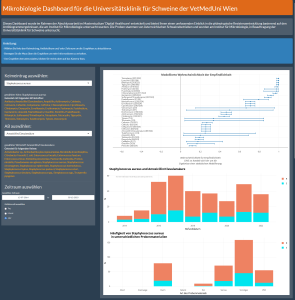Developing and Evaluation of an Interactive Dashboard for Monitoring Antimicrobial Resistance in Austrian Pig Farming
Aim and Research Question(s)
This work aims to develop an interactive dashboard for visualizing laboratory data, focusing on susceptibility data of bacterial isolates from Austrian pig farms. Swine populations, being a potential reservoir for zoonotic pathogens, require close monitoring to ensure the effectiveness of antibiotics and prevent the spread of resistant strains(3). This work addresses the contemporary issue of antibiotic resistance by providing a tool to analyze and interpret antibiogram data from Austrian pig farms, essential for both animal and human health in the frame of One Health approach. Two research questions were formulated: 1. How can laboratory data be visualized to assess phenotypic resistance changes in swine isolates? 2. How is the usability of the dashboard evaluated by intended users?
Background
Dashboards are important tools in healthcare. By visualizing data they can help making data-based decisions faster. User testing ensures usability and effectiveness of dashboards(1). Disease management and surveillance can be improved by including predictive modeling and interactive dashboards. Ultimately, they contribute to public and animal healthcare.
Methods
An interactive dashboard using R Shiny was developed. Evaluation was conducted utilizing quantitative assessment with System Usability Scale (SUS)(2) and qualitative feedback analysis.
Results and Discussion
- Mean SUS score = 79,6
- Modeled Probability of Susceptibility provides comprehensive insights
- Feedback identifies intrinsic resistance issue and proposing future enhancements
- Promising in aiding antibiotic selection and supporting decision-making
Conclusion
The prototype dashboard offers an overview of phenotypic resistance changes, facilitating informed decision-making in swine practice. Feedback from evaluations generally portrayed positive perceptions, with opportunities for improvement noted.
References
- Almasi et al. (2023). Usability Evaluation of Dashboards: A Systematic Literature Review of Tools. BioMed Research International. https://doi.org/10.1155/2023/9990933
- Sauro, J. (2011). Measuring Usability with the System Usability Scale (SUS). https://measuringu.com/sus/
- WHO. (2023). Antibiotic resistance. https://www.who.int/news-room/factsheets/detail/antibiotic-resistance

